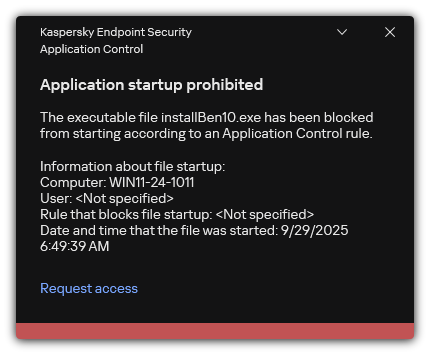Editing Application Control message templates
When a user attempts to start an application that is blocked by an Application Control rule, Kaspersky Endpoint Security displays a message stating that the application is blocked from starting. Kaspersky experts provide a template of a message to the user describing the reasons why the application was blocked (see the figure below). Special variables are provided for managing the message templates (for example, %USER_NAME%). Variables allow a single message template to be used for different computers. When generating a message, Kaspersky Endpoint Security retrieves the value of the variable from the operating system settings and inserts it into the message matching the specific computer, user, and event.

Application Control notification
If the user believes that an application was mistakenly blocked from starting, the user can use the link in the message text to send a message to the local corporate network administrator. To do so, the user must click the Request access button and send a message to the administrator describing the situation. You can also prepare a template of the message to the administrator, adding to it data that may inform your decision to allow or block access to the application. After the user requests to provide access, Kaspersky Endpoint Security sends an event to Kaspersky Security Center: Application startup blockage message to administrator. The event description contains a message to administrator with substituted variables. You can view these events in the Kaspersky Security Center console using the predefined event selection User requests. If your organization does not have Kaspersky Security Center deployed or there is no connection to the Administration Server, the application will send a message to administrator to the specified email address.
How to edit the Application Control message template in the Administration Console (MMC)
How to edit the Application Control message template in the Web Console and Cloud Console
How to edit the Application Control message template in the application interface